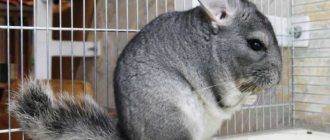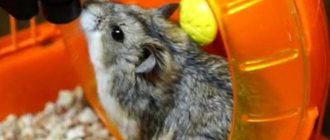The Djungarian hamster is ideal for those who, for one reason or another, do not have the opportunity to have a large pet. This type is one of the most popular. He is not whimsical, does not spread fur around the apartment and does not have the bad habits inherent in some pets. There are no problems with him. Ideal for those who do not have a large area or a lot of extra money. It is enough to select the smallest amount and the animal will delight your eye every day. Children love him very much and are interested in everything about Djungarian hamsters. You can accustom it to your hands and shoulder, after which the animal will be devoted to you every day. It’s just that at night a rustling sound can be heard from the cage; after all, this is a nocturnal animal.
Description
Author: Kristina Forlovskaya
Djungarian hamsters are small animals of the hamster family, the genus Hairy-footed. The body is covered with short, light gray fur. A darker stripe runs along the back; this is how Djungarian hamsters are usually recognized.
The paws are also covered with hair, but white. In clean pets they are a pleasant white-pink color. The ears are small and round. The beady eyes are slightly protruding. The body is small. The body length of an adult dwarf is 10 cm.
Sexual characteristics
It is quite difficult to examine sexual characteristics in a pet store if you have no experience communicating with such small animals. The seller can help. He can hold the animal so that it is comfortable to watch.
If the hamster is a boy, there is a gap of 0.5 cm between the genitals and the anus and there is a formation on the tummy that resembles a navel. If it is a girl, then the gap is almost invisible, and two stripes of papillae run along the tummy.
About the characteristics of the breed
The Djungarian hamster is recognized by its characteristic dark stripe located in the middle of its back. The variegation and white speckles make the animals invisible to predators in their natural environment.
Djungarians can have the following colors:
- standard;
- pearl;
- tangerine;
- sapphire.
As a result of pre-winter molting, the hamster's coat turns white.
Miniature pets rarely grow more than 10 cm and weigh 50 g. They are characterized by exceptional cleanliness, the habit of storing food reserves behind their cheeks, and fussiness. The animal leads a twilight lifestyle, but likes to sleep at any time of the day. Despite its good tameability, the animal experiences bouts of aggression. If you get a hamster for children, you should warn them to be careful. Although a rodent bite is not dangerous, it is quite painful.
Djungarian hamster of tangerine color
Where does the Djungarian hamster live?
Information about where dzhungariks live in the wild will help you better understand their lifestyle and habits. This species can be found in the steppe zone of Western Siberia, in the northeast of Kazakhstan, and in Asia. They live in areas undeveloped by humans.
Lifestyle
There is no hibernation period in winter. On the eve of winter, the hamster grows fat and stores food for future use. This small rodent digs long and deep burrows, which allows it to spend the winter warm. The active time of day is evening and night. They sleep during the day.
What Djungarian hamsters eat in natural conditions determines their diet when kept at home. In the steppe conditions where the Djungarian hamster lives, the food supply is quite simple. It consists of seeds and green parts of plants. The source of protein is small insects and their larvae.
It becomes clear what you need to feed your Djungarian hamster at home. There are subcutaneous pouches located on the sides of the body; they serve for storing and transporting food. Rodents spend most of their lives preparing food.
Gray hamster (Cricetulus migratorius)
Author: Gray Hamster
Author: Gray Hamster
Features of accustoming different species to hands
When buying a hamster, you should pay attention to its breed, since the duration of hand training depends on this.
Dzungarian
“Dzhungariki” are considered the calmest and friendliest, so they easily make contact and quickly get used to the owner. They are more intelligent and intelligent than other species, which makes the training process easier.
Dzungarik in your warm palm shows curiosity about surrounding objects.
Syrian
Syrian hamsters are slow and large in size. The taming process takes longer, but with a good attitude, the pet will willingly go into your arms.
Other types
Campbell's and Roborovsky's hamsters, unlike the "Djungarians" and "Syrians", have a difficult temperament and can be aggressive. You will have to be patient with them, as they are difficult to tame.
Cell selection
The correct choice of cage will determine how many years a Djungarian hamster lives at home. You need to provide your pet with maximum comfort. The size of the cell is important. The hamster will feel great in a cage with the following overall dimensions:
- height – 47 cm;
- width – 36 cm;
- length – 50 cm.
How to arrange a cage
Does how long the Djungarian hamsters live in the house depend on how the cage is equipped? The dependence is direct. For a full life, a cage must have a house. There the pet will hide food and build a nest.
A wheel is required. Choose a less noisy one, otherwise it will be difficult to sleep at night. As soon as it gets dark outside, Djungarian hamsters at home begin to actively spin the wheel.
Ladders and multi-colored plastic tunnels are a must. The animal runs up the stairs, and the tunnel serves as a substitute for an earthen hole.
What do you need for feeding?
The Djungarian hamster receives food in dry form. To prevent food from scattering throughout the cage, you need a plastic or ceramic feeder. Size is important as hamsters fit into the food container and fill their cheek pouches.
A drinking bowl is required; it can be included in the kit that comes with the cage, but you can buy it separately. The volume of the drinking bowl is enough for several days. If the family spends the weekend away from home, there is no reason to worry about what to feed and water the Djungarian hamster at home. There will be enough water in the drinking bowl for several days, as well as food.
Which drinker is better
The choice is clear - you need an automatic drinker, which includes:
- plastic container;
- metal spout with a ball;
- fasteners (for fixing the sippy cup to the bars of the cage);
- tight-fitting tire.
It is not recommended to place open bowls of water in the cage. Dzungarik will certainly knock her over.
What do dwarf hamsters need?
Properly caring for a Djungarian hamster is not at all difficult. You just need to know what your pet needs.
- Cozy home. A large, bright and comfortable apartment - not only people, but also hamsters dream about this. Representatives of the Dzungarian breed require much more space than others, despite its miniature size. The fact is that the animals are very mobile.
- Wheel and other attractions. Toys are necessary to keep your pet from getting bored and keeping fit. And if the size of the cage does not allow you to set up an amusement park there, at least install a wheel - after all, this is not just a toy, but a simulator.
- Mini house inside a cage. The home serves as a resting place and food warehouse.
- Cutlery. There must be a hanging drinking bowl, but you cannot place a saucer with water, the animal will definitely turn it over. The food bowl should be low and stable.
- Food and fresh water.
- Cleanliness in the cage.
As you can see, the dzhungarik does not need much to be completely happy. In addition to the necessary things and food, the fluffy needs communication. Visit your pet several times a day, and in the evening you can even play with it (of course, after the hamster is tamed).
Cage care
Caring for the cage will not take much time. The tray must be filled with sawdust. Pet stores sell compressed sawdust. One pack lasts a long time. The sawdust will need to be renewed periodically.
You don't need to wash the cage very often. The animals are small and the bars of the cage remain clean for a long time. You need to remove and wash the wheel, house, drinking bowl, stairs, tunnels. You will have to vacuum the floor around the cage frequently. Djungarians actively stir up sawdust, building nests, and scatter food if there are family squabbles or they don’t like the food.
How to set up a cage for a hamster: what should be in the house
In order for a pet hamster to live comfortably in captivity, the house needs to be equipped with various accessories. You can buy them together with the cage or separately in specialized pet stores.
What should be in a hamster's house:
- feeder;
- drinking bowl for water;
- toilet with a special filler that absorbs moisture and odors;
- mineral stone for grinding teeth (a tasty and healthy treat);
- gaming accessories - wheels, tunnels, labyrinths and other complexes for outdoor games.
What to feed your Djungarian hamster?
Organizing a nutritious meal is quite simple. You need to go to the nearest pet supply store and find out the range of food for small rodents. You need to feed your Djungarian hamster at home with a feed mixture that includes:
- oat grain;
- sunflower seeds;
- peas;
- nuts;
- corn.
The most interesting thing is that with the same composition of the mixture, the animal eats food from one manufacturer, but not another.
Author: Kruze Victor
Treats
Djungarian hamsters do not live long at home (2.5-3 years) and you can brighten up their life in captivity with a treat. You can find sweet sticks (drops) in any pet store. Drops are made from natural grains and nuts. It is useful to pamper your pet with fresh vegetables and fruits:
- carrots;
- zucchini;
- cucumber;
- apple;
- banana.
What Djungarian hamsters eat fresh should not accumulate in the feeder. Complementary foods should be given by hand and in small quantities.
Author: Alexey Danlovsky
Protein for hamster
The care and maintenance of a Djungarian hamster will not be complete if there is no protein in the animal’s diet. A hamster should receive protein 2 times a week. It could be:
- chicken's meat;
- cottage cheese;
- boiled eggs.
There is an opinion that cheese is harmful to hamsters, but in practice, a small piece of mozzarella cheese does not adversely affect health. The fluffy ball usually flies from all its hamster legs to get its favorite delicacy.
Author: Ekaterina Gorbyl
Mineral feeding
There must be a mineral stone hanging in the cage. As many years as a Djungarian hamster lives, its teeth grow. By gnawing on a mineral stone, the hamster solves a dental problem - grinds down its incisors. In addition, the stone is needed for:
- for normal digestion;
- obtaining necessary microelements and vitamins;
- for a good mood.
Taming stages
Taming the dzhungarik begins with getting to know each other. The further relationship between the pet and its owner depends on how successfully this stage passes. Next, they begin to communicate and treat them to food that hamsters especially love. When contact is established, you can begin training.
First meeting
Finding yourself in a previously unknown environment, the hamster will inevitably experience stress. That is why it is recommended to begin direct acquaintance only a few days after the pet appears in the house. First you need to accustom the animal to the owner's voice.
In order not to frighten your pet, you must first speak to him in a whisper. Gradually, the strength of the voice should increase, reaching the usual level.
Adapting to the sounds associated with the appearance of a person, the dwarf will also get used to the smell of the owner. After the animal begins to calmly respond to the owner’s voice, you can move on to contact with the hand. To do this, it is briefly placed in a cage, sprinkled with a small amount of sawdust.
Communication
When starting to communicate with a furry rodent, you should follow the following recommendations:
- talk to the animal in a calm, gentle tone;
- do not make sharp, loud sounds near the cage;
- Don't be too close when your pet is eating.
It is necessary to talk to the hamster when he eats. As a result, the animal will begin to associate the owner’s voice with the pleasure it receives from food and will respond positively to it.
Already on the first day you need to choose a nickname for the dzhungarika and repeat it as often as possible. The hamster will definitely get used to its name and begin to respond to it.
It is important for the owner to monitor what odors come from him. It is best not to use perfume or other strong-smelling substances before contacting an animal.
Treating yourself with a treat
Among the preferred food for the Djungarian hamster:
- various grains (oats, barley, corn, wheat);
- some vegetables (cucumber, eggplant, carrots, bell pepper, turnip);
- fruits, berries (apples, pears, rose hips, currants, raspberries);
- greens (except onions, garlic, parsley, dill);
- boiled lean meat, egg white;
- young shoots of cereal plants.
It is these products that will be useful for the rodent. You should not give your hamster bread, rolls, fruit pits, potatoes, citrus fruits, sausages, sausages, sea or river fish, cheese, or mushrooms. Such food can harm his health.
Many owners strive to feed their pet by hand, but this will not be possible right away. In the first days, the animal will eat only in the cage where it feels most protected.
Hand Taming
A good way to get used to your hands is to offer them tasty treats. To do this, you need to stick your palm into the cage, putting a little of your favorite treat on it. To avoid spooking the hamster, you should remain still. Having gradually gotten used to the owner, the dzhungarik will begin to eat from his hands and outside his home.
If the rodent does not try to quickly hide at the sight of a person’s hand, but willingly accepts food from it, then all actions were performed correctly. Otherwise, you need to be patient and wait until the animal’s fear completely disappears.
Having noticed signs that adaptation is successful, you can try to pick up the animal. For the first time, you need to stick your palms with treats into the enclosure, fold them into a “boat” and wait until the baby climbs inside.
Under no circumstances should you be too active or take your pet from behind or by the scruff of the neck. The hamster will probably be frightened by such manipulations and bite. You should also explain to other inhabitants of the house that rough treatment is unacceptable - the animal will forever lose trust in people.
Training
Djungarian hamsters are able to learn simple commands and carry them out correctly. To achieve this result, the owner will need to show a lot of patience.
When the animal is completely comfortable, stops showing anxiety in a new environment and begins to regularly eat the food offered, you can move on to training.
Despite their modest size, dzhungarikas are quite smart. They are quite capable of mastering several tricks, including:
- reaction to one's own nickname;
- running in circles;
- standing at attention;
- lifting onto the owner's shoulder;
- somersaults.
To get your hamster to respond to your own name, you need to repeat it often while offering a treat. It is also necessary to address the animal by name during each contact with it.
- Running in a circle . The pet is placed on a surface with small sides and offered a treat. When he starts reaching for food, the owner loudly says “in a circle.” At the same time, you should move the hand containing the treat along the circle.
- Standing at attention . The hamster is seated on a flat surface and a piece of his favorite food is raised above his head. At this moment the command “stand” is pronounced. If you repeat this daily, the animal will begin to rise even without food, but we must not forget to periodically give it a reward.
- Climbing onto the owner's shoulder . The rodent is placed on the palm. At the same time, he should see that the treat is placed on the shoulder and hear the command “up”, “rise” or another. As a rule, the skill is developed after several repetitions. When teaching a pet the described actions, the owner should wear long sleeves.
- Somersaults . This trick will be one of the most difficult. It will take a lot of patience to work it out. The hamster is placed on a flat surface and a treat is placed on its back. To get food, the pet must roll over. When he does a somersault, he must say the command words.
When training a Djungarian hamster, it is necessary to completely eliminate a strict tone and any punishment. You can get the expected result from a rodent only with the help of affection and praise. It is best to work with your pet in the evening, after feeding. It is worth considering that young individuals, no older than three months, show the greatest intelligence.
Does a Djungarian hamster need to bathe?
To keep the animal's fur in good condition, traditional bathing with water is not required. Usually, Djungarians cope on their own; they actively clean their fur with their paws before and after eating. For variety, you can place a container of sand in the cage. Sand for bathing chinchillas is available for sale. One jar will last a long time.
Author: Vasily Prinersky
Unpleasant moments of taming hamsters
During the taming process, the hamster may become aggressive, bite the owner, or get sick. You need to be prepared for difficulties and know how to cope with them.
The rodent constantly bites
If an animal attacks its owner, the reasons for this behavior are:
- curiosity;
- foreign and pungent odors;
- defensive reaction.
You need to pay attention to the nature of the bites. Affectionate and gentle indicate the animal's readiness to play. Strong and aggressive signals about the pet's fear. Pregnant and lactating females can also show aggression - in this case, it is necessary to interrupt physical contact with the animal.
Doesn't eat or drink
If a rodent refuses water and food, this is a sign of severe stress or illness. It is necessary to show your pet to a veterinarian to exclude the possibility of developing the disease. If there are no health problems, you should leave the animal alone so that it can calm down and adapt to its environment.
The hamster is very afraid of humans
Strong fear can be caused by sudden movements, physical violence, or attempts to pull the animal out of the house. It is necessary to identify the cause of fear and eliminate it. Frequent feeding with treats and providing a calm and comfortable environment will help restore your pet's trust.
Does a Djungarian hamster need a mate?
There is an opinion that hamsters should be bought in pairs. It's a delusion. Hamsters prefer a solitary life. A partner is needed only for the mating period, and the rest of the time the female and male can live happily alone.
You must be prepared for daily fights if you decide to purchase two or more hamsters and keep them in the same cage. The battle for territory is usually accompanied by a loud squeak.
We can conclude that how many years Djungarian hamsters live at home absolutely does not depend on the presence of a partner. In most cases, the dwarf lives happily in its cage alone, and it doesn’t matter whether it’s a male or a female.
Author: Elizaveta Gaday
Author: Vasily Poklonsky
Animal character
Dzungariks cannot be called too sociable. Having an independent nature, rodents do not need close contact with a human being. And if the owner wants to get an affectionate and sociable pet, he will have to make an effort and be patient.
Taming a rodent once and for the rest of its life will not work. If you don't talk to him for a couple of weeks, he will go wild again.
Therefore, if you have already decided to interact closely with your pet, then you need to do this constantly.
You should also follow your pet's daily routine without disturbing him during daytime sleep. Most likely, the main communication will occur in the evening hours, when the furry-legged furry is already awake, and the owner has finished all the day’s activities and can relax in the evening silence.
If you cannot find some little thing that is vital, look for a rodent in the house.
The thrifty nature of animals is evident in everything; they carry not only food to a safe place.
You should not put several animals in one cage.
Individual farmers by nature, Djungarians will definitely fight for territory. It is also necessary to timely separate the grown offspring from the mother.
Reproduction of Djungarian hamsters
If under natural conditions hamsters mate from March to September, then reproduction in captivity occurs all year round. Naturally, when individuals of different sexes come into contact.
Properly organized care and maintenance of hamsters at home requires the presence of several cages. The female and male live in different cages. The male is placed in a cage with the female for a short period of time. It only takes a few days for a female to become pregnant.
It is necessary to know how long pregnancy lasts in Djungarian hamsters in order to place the male in another cage in advance. Pregnancy lasts about 3 weeks. During this period, the female's behavior changes. She sets up a nest, fusses, stores food. If at this time the male is in the same cage with her, family scandals are inevitable. The squeak will be heard throughout the apartment.
A pregnant female needs to be given rest. Tell the children about her interesting situation and ask them not to pick her up.
How long does pregnancy last for a Djungarian hamster?
Females become sexually mature at 1.5 months. During the warm season (March-September) they mate several times and produce 3-4 litters. Pregnancy lasts 3 weeks.
Author: Pavel Moroz
What to feed during pregnancy?
For full reproduction, the Djungarian hamster (female) must receive food as usual, plus additional protein supplements in the form of meat, egg white and cottage cheese. This diet is maintained for the entire period of feeding the cubs.
Offspring
The maximum number of cubs is 10-11, but may be less. The cubs will be born blind, pink, and without fur. After just 10 days they become independent individuals and can serve themselves.
We must remember: you must not touch blind cubs. The female can eat such a baby. They also eat sick offspring, intuitively feeling that the cub is not able to live fully. When purchasing hamsters, you need to be prepared for such unpleasant moments.
Author: Vitaly Nalyvaichenko
When can you start training your hamster?
If the rodent completely trusts the owner, you can begin training. Young individuals are more receptive to learning, and hamsters older than 3 months have already formed character and habits.
Workout
Classes are held in the evening - at this time the animal demonstrates the greatest activity. It is important that your pet is slightly hungry, otherwise he may ignore treats that are used as rewards.
Before class, you need to thoroughly wash your hands and make sure that the animal is ready to play. You cannot train a lethargic, sleepy or frightened animal.
Tricks
You should start with simple tricks, for example, teaching your pet the “run” command. To do this, you need to take a treat and bring it to the hamster’s nose, clearly say “run” and move your hand along a random path.
When the rodent runs 1 or 2 laps, it is fed a treat and the process is repeated. With regular training, the hamster will soon remember the trick and will perform it without treats. In the same way, you can teach the animal other commands.
Diseases of the Djungarian hamster
A hamster, like any living creature, can have health problems. You need to find out in advance what diseases can lie in wait for Djungarian hamsters. Signs your pet's health is deteriorating:
- dull or shiny coat;
- lack of appetite;
- reduced motor activity - the hamster runs a little, sits more.
Hamsters have different diseases. The animal may simply have a cold. A cold is accompanied by heavy breathing and wheezing. You can offer the dzhungarik fresh fruit. They improve immunity.
Mechanical injuries are possible. Hamsters are very mobile and can dislocate a paw if they fall badly. Suspicion of injury is a reason to take your hamster to the veterinarian for examination and consultation.
Weak spot of the eye. Hamsters have common conjunctivitis, which is treated with rinsing (chamomile tea, calendula). Age-related problems with the eyes that are not treated.
Djungarians sometimes have tumors, not to be confused with pregnancy and swollen sides due to cheek pouches stuffed with food. For any serious health problems, you should visit a veterinarian. How long Djungarian hamsters live depends on the owner.
Prevention and treatment of diseases
The most common diseases of dzhungariks:
- obesity;
- diseases of the cardiovascular system;
- problems with the gastrointestinal tract;
- eye pathologies;
- dermatitis.
To prevent diseases, you need to monitor the animal’s nutrition and hygiene, provide conditions for physical activity, protect the hamster from hypothermia and stress, and ensure that it does not get injured during walks and games.
It is not recommended to treat jungaric diseases on your own. It is difficult to carry out home diagnostics, and improper care can worsen the pet’s condition. Djungarian hamster
Therefore, if symptoms of the disease appear, the animal should be taken to a veterinarian or a more specialized rodent specialist - a ratologist.
How to choose and buy a Djungarian hamster?
Having learned everything about the care and maintenance of the Djungarian hamster, go to the pet store to buy one. What should you be interested in at this time, besides how much a Djungarian hamster costs? You need to decide for yourself how many animals you want to buy and whether you will breed.
Considering that hamsters do not live long, a maximum of 3 years, very rarely 4, you need to choose young hamsters. A good age for purchase is 3-4 months. Young hamsters get used to being handled more easily and become full-fledged partners for the child.
Author: Mikhail Reshetov
How long does it take for hamsters to form attachments?
The adaptation period lasts from 4 to 8 days, and the formation of attachment to the owner can take from a couple of weeks to several months. You cannot force events - the animal must learn to trust the owner.
If the animal is fussing and nervous, this indicates that it is afraid of humans.
It is believed that males are easier to train and tame. Girls are more obstinate and timid, and boys are calm and affectionate.
The hamster must be handled voluntarily and should not be grabbed roughly.
Additional accessories
The list of optional elements that can be collected in the animal’s “dowry” includes:
All these accessories will bring additional joy to your pet, but may well be classified as excess.
Important! When choosing additional accessories, you need to pay attention to their quality. There should be no cracks or crevices on the surface of the toys that the animal’s paws could get into.
Hamsters are active and unpretentious animals that are ideal for keeping at home. And in order for them to please their owners with funny pranks longer, they need a spacious cage with all the necessary elements.
Source
How often to clean your home
In order to maintain a healthy, favorable atmosphere inside the cage, it is necessary to regularly clean it. As mentioned above, every day you should spot clean bedding material that is contaminated with rodent excrement, food or plain water. Thorough cleaning of the home is carried out every 2–4 weeks.
Cleaning the cage includes several steps:
- remove the hamster and transfer it to a jar or other container;
- change the bedding to a new and clean one, leaving some of the bedding so that the hamster’s smell does not disappear completely;
- Wash the tray with warm water using baby detergents or special preparations;
- Using a regular sponge soaked in water, wipe the rods. Wipe all accessories with a dry cloth.
Video: cleaning a hamster's cage After cleaning the home, it is very important to return all items to their original places.
Important! It is better not to touch the food reserves hidden by the pet - if they are not found, the dwarf can experience a great shock. You only need to remove spoiled foods that can poison your hamster.
Where to put a cage with a rodent
The hamster cage can be placed in any convenient place in the house, with the exception of some potentially dangerous areas.
You cannot place a house with a pet near heating appliances, in drafts or on the floor. It is also not recommended to place the structure next to furniture, curtains and a wall with wallpaper. A rodent, due to its natural instincts, can gnaw everything that comes within its access zone.
Hamsters are quite shy animals and cannot tolerate loud sounds, so it is also not recommended to place a cage with a pet near a TV, musical equipment and other household appliances that make a lot of noise. Buying a cage for a hamster is not difficult. Modern pet stores have a large selection of designs for pet rodents of different breeds and sizes. The main thing is to take into account all the listed criteria when choosing and create the correct arrangement of the home so that the pet can be active, beneficial for its health.











